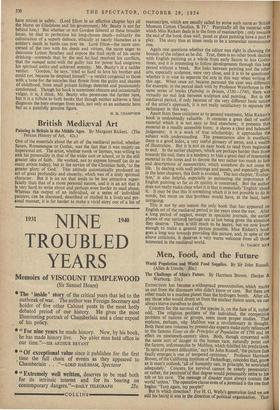British Mediaeval Art
Painting in Britain in the Middle Ages. By Margaret Rickert. (The Pelican History of Art. 42s.) ONE of the essentials about the art of the mediaeval period, whether Saxon, Romanesque or Gothic, was the fact that it was mainly an impersonal art. The artist, whether monk or layman, was willing to sink his personality in that of the wider unit or school, or in the still greater idea of faith. He worked, not to express himself (as do so many artists today), but in the service of the Christian faith, 'to the greater glory, of God.' This attitude automatically produced an art of great profundity and sincerity, which was of a truly spiritual character. But it is an art that tends to be less attractive super- ficially than that of a more personal nature, and it is an art that it Is very hard to write about and perhaps even harder to read about. Whereas the output of an individual, or a series of individual painters, can be discussed, described or studied in a lively and per- sonal manner, it is far harder to make a vivid story out of a list of manuscripts, which are usually called by some such name as 'British Museum Cotton Claudius, B. IV.' Practically all the material with which Miss Rickert deals is in the form of manuscripts ; only towards the end of the book does wall, panel or glass painting have a part to play. The story thus at times tends to be a somewhat monotonous one.
Again one questions whether the editor was right in choosing the bounds of the subject as he did. True, there is no other book dealing with English painting as a whole from early Saxon to late Gothic times, and it is interesting to follow developments through this long period without a break. But links between painting and the other arts, especially sculpture, were very close, and it is to be questioned whether it is wise to separate the arts in this way when writing of this age. When once art became personal the case was different; for example, in the period dealt with by Professor Waterhouse in the same series of books (Painting in Britain, 1530-1790), there was virtually no real link between sculpture and painting. But in the mediaeval period, if only because of the very different basic nature of the artist's approach, it is not really satisfactory to separate the techniques in this way. Apart from these criticisms as to general treatment, Miss Rickert's book is undoubtedly valuable. It contains a great deal of useful material which it is not easy to find elsewhere; it presents that material in a readily accessible form; it shows a clear and balanced judgement; it is a work of true scholarship; it approaches the subject with understanding. The presentation also is excellent; there is a good index, a very useful glossary of terms, and a wealth of illustration. But it is not an easy book to read from beginning to end. In the earlier chapters, which are perhaps harder than those towards the end, there is a tendency to hide a great deal of interesting material in the notes and to devote the text rather too much to lists and descriptions of manuscripts, which somehow do not come to life. In dealing with wall paintings and panels, and especially glass, in the later chapters, this fault is avoided. The last chapter, 'Evalua- tion,' is also helpful, especially in estimating the importance of English painting so far as its quality is concerned. But the author does not really make clear what it is that is essentially 'English' about it. It may be that this is something which it is not possible to do in words, but more on this problem would have, at the least, been intriguing.
This is not by any means the only book that has appeared on English art of the mediteval period in the years since the war. After a long period of neglect, except in specialist journals, the earlier phases of our national heritage are at last being given the attention they deserve. There is still much to be learnt, but we now know enough to make a general picture possible. Miss Rickert's book goes a long way towards providing this picture, and, in spite of the above criticisms, it deserves a very warm welcome from all those interested in the mediaeval world. D. TALBOT RICO


































 Previous page
Previous page